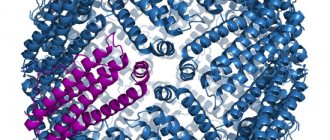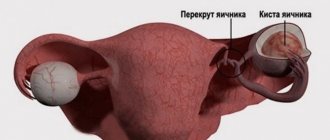Ferritin
plays an important role in the normal functioning of the body.
This is a protein that is responsible for iron deposition, tissue and organ regeneration. Normal ferritin levels should be 100 micrograms per liter (mcg/L), regardless of age or weight.
In some laboratories, current reference values exceed 100 μg/L. It is necessary to monitor this indicator from childhood, since there is a category of people who have low ferritin levels from birth. As a rule, it is inherited on the maternal side.
Low ferritin levels
When ferritin levels are low, the regeneration process slows down.
This negatively affects the functioning of primarily organs that have an aggressive environment - the stomach, urethral canal, intestines, vagina, and oral cavity. The outflow of lymph is disrupted, it is retained in the tissues, which leads to lymphostasis. The skin suffers because ferritin is involved in the formation of collagen.
What symptoms indicate that you should check your ferritin levels?
Oral cavity.
Seizures in the corners of the mouth, dry, chapped lips, recurrent and long-lasting stomatitis. Damage to the tip of the tongue, tingling, sour taste - this occurs not only due to reflux and esophagitis, but also when the oral mucosa cannot recover.
Stomach.
Ulcers, erosions, bad breath that does not go away with the drug treatment received.
Intestines.
Frequent diarrhea, loose or pasty stools, gas and bloating.
In addition to treating the gastrointestinal tract, it is imperative to check your ferritin level.
Vagina and urethral canal.
Persistent and recurrent candidiasis, cystitis, which can occur without pain.
Lymphostasis.
Lymph consists of 80% protein - ferritin. It is a transport fluid that takes toxins from the site of intoxication and delivers them to the blood. In this way, the body self-cleanses. Disruption of this process has several manifestations - swelling and frequent or prolonged colds. Swelling is most pronounced in the first half of the day and goes away on its own by lunchtime or evening. Not only the face swells, but also the limbs. Colds are sluggish and recur.
Poor skin healing.
Low ferritin levels lead to poor collagen production. The skin loses its protective properties, since the collagen it contains is not enough to withstand ultraviolet radiation and temperature changes (cold or heat). Pigment spots may form on the skin, including those of the vitiligo type. Turgor decreases. Small wounds and cuts do not heal for a long time. Spots form at the sites of damage that do not go away within 2-3 years. After plastic surgery, instead of invisible seams, scars are formed, sometimes with pigmentation. When applying a tattoo, instead of the desired black shade, you may end up with a greenish or gray shade, which will also not stick well. Facial asymmetry with Botox injection can also occur due to low levels of collagen in the skin.
Ferritin: what is it?
Ferritin is a complex complex of proteins that plays the role of a battery of iron molecules. From the Latin name of the chemical element iron (ferrum, Fe) comes the name of the iron-containing protein complex - ferritin. It is ferritin that supplies iron to every cell that needs it.
The human body does not synthesize iron itself. This element comes to us with food. The level of iron absorbed directly depends on age. The younger a person is, the higher his ability to isolate this element from food and store it in the form of ferritin. Children in the first year of life can absorb the maximum amount of iron – up to 70% of the amount consumed. By the age of 10 years, the body shaves 7 times less of the incoming volume. Adults receive only 10% of the iron they eat per day.
The chemical processes of a healthy person’s body clearly control the amount of iron in the blood and, if necessary, adjust the distribution of the resulting volume of elements. For example, with a sufficient amount of iron in the body, the absorbed part of it can be set aside as a kind of preparation “for a rainy day” - this is ferritin, which, when the first need arises, will deliver iron in the required volume to the organ in need. And with a reduced concentration of iron in the body, ferritin does not replenish its reserves, since the entire absorbed volume is immediately distributed throughout the tissues.
Ferritin is located in the liver, plasma, bone marrow, placenta and spleen. The level of total ferritin in the body is determined by studying the composition of blood plasma.
Low ferritin levels in the body: symptoms, dangers and methods of control
Ferritin is essentially a protein ball that contains many iron ions in the form of Fe3+. Ferritin is deposited in the liver, spleen, bone marrow, and muscles. Another small percentage of it circulates in the blood. The loss of ferritin is physiological: every day a person loses this substance through the intestines, and women also lose it through menstrual blood.
Iron is a component of hemoglobin and red blood cells, and is therefore responsible for the transport of oxygen in the blood. Iron deficiency is the most common cause of anemia. But there is also a hidden iron deficiency: the hemoglobin level is within normal limits (still!), and ferritin is low. What signs allow you to suspect that you have this condition, what does it mean and how to deal with it?
Symptoms of Low Ferritin Levels
What ferritin level is considered normal? It all depends on age and gender. Plus, the standards differ from one laboratory to another.
Symptoms of hidden iron deficiency are varied.
- 1. Fatigue
May signal that there is not enough iron in the muscles. You feel tired all the time: long walks or climbing stairs become difficult. A mini-jog to the departing bus is already perceived as a marathon, and regular sports training makes you feel sick.
- 2. Cognitive impairment
It may mean that the brain is not getting enough iron. Severe anxiety for minimal reasons, irritation, deterioration of memory and attention. Emotional stress can cause insomnia.
- 3. Weakening of the immune system
Iron is essential to fight infections. With its deficiency, a person gets sick more often than usual; exacerbations of diseases such as cystitis or herpes occur several times a year.
4. Headaches
Regular and quite severe.
- 5. Appearance
Deterioration of nails, dry skin, hair loss - all this can also occur due to iron deficiency.
Methods to increase ferritin levels
The most important thing is that you cannot raise your iron levels with diet alone. No. No way. And that's why.
To treat iron deficiency, you need to take 100 mg of elemental iron daily for three months or longer. If you try to do this with food, every day you need:
- ● or eat a kilogram of lentils;
- ● or drink 10 glasses of pomegranate juice;
- ● or eat half a kilo of sesame seeds.
As you understand, this is impossible. A diet rich in iron can well support a person with normal ferritin levels and severe stress on the body: during pregnancy and breastfeeding, during the period of active growth in children, and during intense physical activity. But if there is a severe deficiency of ferritin, you need to start taking medications - in fact, this is the only effective way to increase the level of ferritin in the blood.
The most common preparations with divalent iron are iron gluconate or ferrous sulfate (the latter are more common than the former). Their therapeutic effect is approximately the same.
Doctors also prescribe vitamin complexes with ferric iron: it is absorbed a little worse, but it is better tolerated and has fewer side effects. As a rule, in addition to iron, preparations contain folic acid, manganese, copper and vitamins C and B12. You should not select the drug yourself, since taking iron has its own characteristics. It may interact with other drugs: these points should be taken into account by the attending physician.
Ferritin: normal levels
Various diseases or certain physiological processes can affect ferritin levels. Natural reasons for decreased performance include:
- periodic female bleeding;
- pregnancy;
- dieting.
To monitor health status as a preventive measure, as well as in case of symptoms typical of iron deficiency, a biochemical blood test for ferritin is performed. The collected biomaterial is examined to understand how many micrograms of iron are contained in one liter of plasma.
The norms for each age group are different:
- in newborns from 25 to 600 mcg/l;
- in children older than 28 days, but not yet 9 weeks of age, the norm is 20-600 mcg/l;
- in children from 2 to 5 months it should be from 50 to 200 mcg/l;
- children aged from six months to one year should have from 70 to 140 mcg/l;
- girls and women over 12 years of age should have a normal level of 22 to 180 mcg/l;
- boys and men over 12 years old - from 30 to 310 mcg/l.
Women's blood contains less ferritin because it contains less hemoglobin, red blood cells and iron molecules. In addition, pregnancy makes its own adjustments to ferritin levels:
- in the first trimester of pregnancy, levels can reach 90 mcg/l;
- in the second trimester, blood contains up to 74 mcg/l;
- and the third trimester is famous for its low ferritin level - only 10-15 mcg/l.
Low ferritin levels. Good hemoglobin is not yet an indicator
Do you get tired out of the blue? Your body may not have enough iron. Doctors say that many Belarusians experience iron deficiency, but they don’t even know about it.
“There are concepts of iron deficiency anemia and latent iron deficiency,” Tatyana Rachkova, head of the consulting department of the Minsk Clinical Consulting and Diagnostic Center, told a 1prof.by correspondent. – Anemia is indicated by a low hemoglobin level, but a latent state is when the hemoglobin level is still normal, but iron reserves are already depleted. One hundred percent confirmation of this condition is low ferritin levels. The development of iron deficiency can be caused by diseases of the gastrointestinal tract, and in women - by gynecological problems. As practice shows, 30% of Belarusian women of reproductive age suffer from a latent form of iron deficiency; iron deficiency anemia occurs in 10%. This is a fairly large percentage, considering that I do not take into account pregnant and lactating women.
– What symptoms should make a person check their blood for ferritin and why are we talking about it?
– The ferritin level always reflects the real picture of things, while serum iron is a rather subjective indicator, it can change for various reasons. As for symptoms, it’s better not to wait for them: each of us should take a routine blood test at least once a year. It is necessary to perform a general blood test and ferritin level out of hours if you begin to feel uncharacteristic weakness during normal physical activity. Other common symptoms include: shortness of breath, a feeling of lack of air in a poorly ventilated room (although previously you could tolerate such an environment quite calmly), lightheadedness, brittle and depleted nails, hair loss, perversion of taste: people want to eat dry buckwheat or chalk.
To determine the cause of iron deficiency, it is necessary to undergo available examinations. Women, first of all, should be examined by a gynecologist, since even heavy menstruation can gradually deplete iron reserves. The second step is to, as people say, “swallow the probe.” The fact is that a biopsy performed during this procedure will help determine the problem that impairs the absorption ability of the stomach. If it is reduced, then, of course, a person will lack many useful substances, including iron.
– It turns out that anemia can occur in people who eat according to the principle “I eat meat with meat”?
– Certainly. If the absorption capacity of the gastrointestinal tract changes, no matter how much beef or offal we eat, the body will receive less than it needs.
– Let’s say the root cause has been eliminated. Can you replenish your iron supply with food alone?
– No anemia can be treated solely by diet, since there is not enough iron in foods for a therapeutic effect. This requires taking special medications. When taken orally (tablets), there will be no overdose: the body will remove the excess itself. An excess of iron, which is also dangerous to health, can be caused by intramuscular and intravenous injections. Therefore, you cannot self-medicate; injections must be given strictly as prescribed and under the supervision of a doctor.
– Are there any features of the development of iron deficiency in children?
- Eat. For example, babies whose mothers experienced a lack of the element during pregnancy are at risk. It should also be taken into account that children in the first year of life grow very quickly and they require more iron than adults. This is why pediatricians recommend introducing complementary foods from the age of six months: oddly enough, breast milk today contains less iron than special milk formulas. Deficiency can also be caused by frequent infectious diseases (they require greater iron intake). That is, if the child is healthy and is on an adequate, balanced diet, then, most likely, he will not face iron deficiency conditions. But in any case, a blood test once a year is mandatory for children too.
– You mentioned “adequate” nutrition. Is vegetarianism a risk factor or is it the norm?
- I’ll answer this way. Iron is absorbed more intensively by our body in its divalent (heme) form. Animal products contain just such iron, as well as essential amino acids and protein necessary for the iron to be built exactly where it is needed. Plant foods contain only ferric iron, which means it is absorbed much less well. If a vegetarian also has some related health problems, we will definitely come up with iron deficiency. I cannot dictate a person’s diet. But as a doctor, I am obliged to warn about this development of events. It is clear that there is no need to abuse protein, but completely abandoning it is also bad. Constantly replenishing iron through synthetic drugs is not an option. Iron in the form of tablets and vitamins is in some sense foreign to the body. Essentially, it is an aggressive chemical element that can cause micro-erosions when absorbed. It’s one thing when it is prescribed for medicinal purposes, and quite another when a person himself decides to abuse the body by replacing food with a drug.
– Now doctors often prescribe a general blood test with a detailed leukocyte formula. What it is?
– The general analysis includes only indicators of hemoglobin, platelets, leukocytes and erythrocytes. And they can be quite normal thanks to the adaptive capabilities of the body. And in the leukocyte formula, the percentage of different types of leukocytes is determined, which makes it possible to suspect even the prerequisites for some problem or a disease in the initial stage. Therefore, I insist on precisely this detailed analysis.
– We talked to you about low hemoglobin. What does the increased rate indicate?
- About the fact that you need to pay attention to yourself. Many rejoice, seeing a very high level in the analyzes and in vain. This condition is called symptomatic erythrocytosis. First of all, smokers (due to a constant lack of oxygen in the tissues) and people with high blood pressure are susceptible to it. In addition, high hemoglobin carries a risk of dangerous thrombotic situations. Therefore, even with a high hemoglobin level, it is necessary to consult a specialist.
It is also necessary to mention such an important indicator as platelets; I note that previously this indicator was not included in a routine blood test. Now such studies are mandatory. And this is very good. For example, a low platelet level (above 50 thousand) does not manifest itself in any way in everyday life. But this is the first indicator of the risk of bleeding, which can only reveal itself with surgery. Therefore, I repeat once again: do not neglect preventive tests and take care of yourself.
Interviewed by Elena ORLOVA
Why is low ferritin dangerous?
A decrease in ferritin levels is primarily an indication for analysis of the nutritional system. Most often, insufficient iron levels in the blood are caused by improper diets or fasting. The second most popular cause is bleeding and diseases of the digestive system. With blood loss, large volumes of iron leave the body, and due to impaired absorption function, the deficiency cannot be replenished.
With a lack of ferritin, the following symptoms appear:
- brittle nails;
- hair loss;
- decreased libido;
- mood swings;
- increased heart rate;
- dizziness;
- memory impairment.
Low ferritin, if not detected in time, and nutrition adjustments and the necessary treatment are not started, can become an impetus for the development of iron deficiency anemia.
How to replenish ferritin levels?
Iron supplements do not increase ferritin levels because ferritin is a protein. Patients who have taken iron supplements for 2-3 months, or received iron intravenously, are faced with the fact that the level of iron in the blood is increased, while the level of ferritin has not changed. Despite the fact that ferritin can be obtained from food, it is not possible to compensate for the deficiency in this way. It is necessary to take artificial drugs. During inpatient treatment, the patient receives droppers with plasma and plasma-substituting solutions. In outpatient settings, spirulina, chlorella, and collagen are used to increase ferritin levels.
Algae with pyruline and chlorella
Spirulina and chlorella
- These are blue-green freshwater algae. They do not contain iodine, so they can be prescribed to patients with thyroid diseases. Spirulina and chlorella are identical in chemical composition. The difference lies in the percentage of microelements and electrolytes in their composition. Chlorella contains 30% less protein than spirulina. Collagen can lead to crystallization of bile and urine. If the patient has a history of cholelithiasis or bile sludge due to long-term use of contraceptives and hormones, then collagen is prescribed in a short course, no more than 1 month, under dynamic ultrasound control of the gallbladder. Therefore, of the three drugs, preference is given to spirulina, as the most effective and safe.
The average course of taking spirulina is 3 months.
The drug is taken 3,000 mg (one-time) per day. Ferritin levels must be checked over time. The analysis is given after 1 month of admission. If the ferritin level has increased by at least 20 units, we can talk about positive dynamics and continue taking the drug for another 2 months. When increasing by 5-10 units, it is necessary to increase the dosage to 5,000 mg (one-time) per day, or combine with collagen. A control analysis also after 1 month of use. The course must be repeated once every six months, since the protein supply is spent to ensure the normal functioning of the body, it must be periodically replenished.
It is not recommended to give spirulina to children as a preventive measure.
Before taking the drug, you should check your ferritin level.
Protein deficiency. Why does the ferritin level not increase during therapy?
Where and how is iron absorbed?
Iron contained in foods of plant and animal origin is absorbed in the duodenum and jejunum. To do this, iron must undergo a series of transformations in the stomach.
Once in the stomach, under the influence of hydrochloric acid, food proteins must be broken down into amino acids. This process is called denaturation or primary hydrolysis of the protein. The synthesis of amino acids and the accumulation of protein in the body are promoted by vitamins B12 and B6 (folic acid), the absorption of which depends on the acidity in the stomach. Normal pH is 2.8, outside the stomach - 3.5.
High ferritin levels
High ferritin, close to the normal limit, indicates that tissues and organs receive a sufficient amount of iron every day from the diet, thanks to which the body is able to store reserves of an important element. If the values obtained as a result of laboratory tests gave inflated indicators, significantly beyond the acceptable limits, this is a reason to examine to identify:
- oncology;
- infection with the immunodeficiency virus;
- problems in the functioning of the endocrine system.
Separately, you need to analyze your diet. Perhaps excess iron can easily be explained by a diet rich in this element.
Still have questions? Contact us:
Elevated levels of ferritin and vitamin B12
Both a decrease and an increase in ferritin levels are associated with hormonal imbalances, namely the function of the thyroid gland and pituitary gland. There are a number of other reasons that can trigger an increase in ferritin levels.
Reasons for increased ferritin levels:
- increase in the hormone prolactin with hyperprolactinemia;
- decreased TSH levels in hyperthyroidism;
- acute and chronic liver diseases. The attending physician must determine the cause of the increase in ferritin in this case. For example, chronic cholecystitis and hepatitis are not in all cases the cause of increased ferritin levels;
- hereditary disease – hyperchromatosis. With this disease, iron contained in food is absorbed in excess quantities and distributed in tissues, where it is destroyed. This leads to intoxication and increased ferritin levels;
- hemolytic anemia is a blood disease in which pathological damage and subsequent breakdown of red blood cells occurs;
- inflammatory processes in the body, cancer (bone marrow cancer, breast cancer, Hodgkin lymphoma);
- taking combined oral contraceptives. Taking estrogen for more than 6 months;
- diet abuse, starvation;
- uncontrolled use of multivitamins, dietary supplements, iron supplements (especially in injection form - intravenously or intramuscularly);
- in some cases, drinking alcohol.
Reasons for increased vitamin B12 levels:
A person is born with normal levels of vitamin B12. The reason for the increased level of vitamin B12 is simple - it is an overdose. You cannot take vitamin B12 without getting tested. If vitamin B12 levels are normal, supplemental intake “for prevention” will lead to excess accumulation.
How to reduce elevated ferritin and B12 levels?
It is not possible to reduce elevated levels of ferritin and vitamin B12 with medications
. There is no antidote. Waiting tactics are used. The patient is examined for concomitant diseases. If detected, treatment is prescribed. At the same time, the level of ferritin and vitamin B12 is observed in dynamics. If after 1.5 months the analysis shows that the level has decreased, then we can talk about good dynamics, and it is worth taking the test again after 1.5 months to confirm the result. If the level, on the contrary, has become even higher, then it is necessary to further examine the patient.
You can speed up the decrease in ferritin and vitamin B12 levels with hirudotherapy, bloodletting and eliminating red meat from the diet.
There are contraindications for these methods; the use of any of them should be discussed with your doctor.
Before undergoing a course of hirudotherapy, it is necessary to donate blood for clotting (coagulogram). People with high blood pressure and diabetes should also consult a doctor first.
To reduce the level of ferritin and vitamin B12, 2 courses of hirudotherapy with an interval of 1 week are sufficient. The minimum number of leeches is 7-8 pcs., the maximum is 10-12 pcs.
Currently, there are two methods of bloodletting: taking blood from a vein and Hijama. Venous blood is collected exclusively in the treatment room under the supervision of a physician. The minimum amount of blood taken is 150-200 ml, the maximum is 300 ml. The procedure is repeated 2 times with an interval of 1 week. Cupping is used in the Hijama technique. This happens as follows: an incision is made on the skin, the blood is sucked out using cups.
As for temporarily excluding red meat from your diet, if you can’t completely give up this product, you should at least reduce your consumption. Red meat (beef, pork, lamb, horse meat, camel and other animal meat) should be consumed once every 10 days, or at least once a week. If a person cannot eliminate red meat at all, then white meat (poultry, rabbit, fish) can be added to the diet. Single dose in the amount of 150-200 g. 2 times a week, in the morning, or no later than 16:00.
Anemia: what is ferritin and what is it eaten with?
Currently, according to various sources, the prevalence of iron deficiency anemia (hereinafter referred to as IDA) varies from 5% to 40% among the adult population, and among pregnant women it reaches 50%. In the usual sense, the diagnosis of IDA is based on a general blood test, which shows a decrease in hemoglobin, as well as symptoms such as dry skin, fatigue, brittle nails, perversion of taste, and pale skin. However, today it is of great importance not only to determine the decrease in hemoglobin in the blood, but also other indicators involved in iron metabolism, the most important of which is ferritin.
Ferritin is a protein that reflects the level of iron reserves in the body. It is highly specific in diagnosing anemia. When symptoms are severe and hemoglobin is low, this indicator is necessary to separate iron deficiency anemia from the anemia of chronic diseases, the treatment of which may vary depending on the cause. With iron deficiency anemia, there is a decrease in ferritin, the norm of which is 40-60 mcg/l for both adults and children, but the norm is often calculated individually, based on weight.
In addition to clinically pronounced IDA with a decrease in hemoglobin, there is such a thing as latent iron deficiency, which cannot be diagnosed using a general blood test. Ferritin is the most indicative for diagnosing hidden iron deficiency. The question arises: “Why is it necessary to diagnose latent iron deficiency in principle if there are no manifestations of anemia?” Diagnosis of latent iron deficiency in the blood before the onset of symptoms is necessary for people at risk for further prevention.
Risk groups for IDA include:
- women with heavy menstruation;
- pregnant women;
- blood donors;
- people with constant chronic blood loss (gastric, hemorrhoidal, nosebleeds, intestinal bleeding);
- people with diseases leading to impaired iron absorption (mainly inflammatory bowel diseases);
- premature babies;
- people on a special diet due to personal beliefs (vegetarian and vegan diets);
- people who constantly take painkillers from the group of non-steroidal anti-inflammatory drugs.
These groups of people are recommended to take a complete blood count, serum iron and ferritin at least once a year, with the exception of pregnant women who need monitoring during pregnancy and the postpartum period.
In addition to its reserve function, ferritin is an acute phase protein, that is, a protein released during acute inflammatory diseases, as well as during the breakdown of one’s own tissues, for example, during cancer. In this regard, normal or increased levels of ferritin may be observed in case of iron deficiency, therefore, in such conditions it is not recommended to focus on this indicator. Also, sometimes when diagnosing iron deficiency, a normal serum iron level with a decreased ferritin level may be observed. In such situations, the determining factor is the ferritin level, since the iron level can be subject to strong fluctuations and does not always reflect the real picture, unlike the ferritin level.
If latent iron deficiency or IDA is detected, the doctor prescribes iron supplements depending on the severity. It is incorrect to believe that iron deficiency can be compensated only by diet therapy, that is, by increasing food intake containing a high content of Fe2+, since there is a maximum amount of iron absorption per day from foods (a person is not able to consume the amount of food that is necessary to restore normal iron levels) .
Thus, the diagnosis of anemia is not limited to just a general blood test. The decision to prescribe iron metabolism indicators is made by the doctor, including which indicators are needed at the moment. It is also necessary to remember that it is impossible to choose the right treatment on your own, without guidance from a doctor, and this can often be dangerous. Therefore, if you are at risk or notice symptoms of anemia, consult your doctor.
Making an appointment with a general practitioner
To clarify the details, consult a qualified specialist at the Semeynaya clinic.
Single contact center
8 495 662-58-85
daily from 8 to 21
To find out more about prices for seeing a therapist or other questions, please follow the link below:
Therapy









